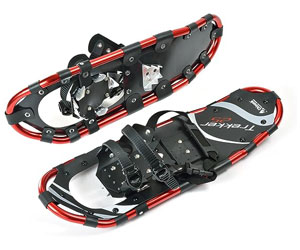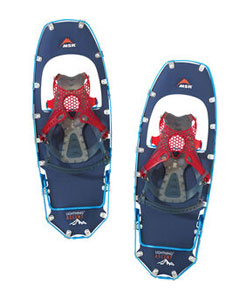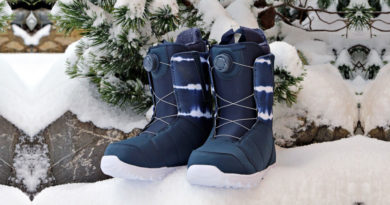Best Budget Snowshoes of 2023-24
A pair of snowshoes adds extra traction underfoot and provides a bigger platform for floatation. They also spread your body weight over a larger surface, which prevents your feet from punching through the snowpack. With a good pair of snowshoes, you can hike your favorite terrain with all the winter fun. However, snowshoes can get expensive. An average pair will cost you around $200 to $250 with the necessary features. But don’t worry. There are some good budget-friendly options available that you can get without breaking the bank. They provide good features and quality at an affordable price. So keep reading to learn more.
1. Tubbs Flex STP

Category: Trail
Weight (pair): 3 lbs. 8 oz.
Length: 24 & 28 in.
Tubbs Flex STP is a good option for you if you are new to snowshoeing and want to save some cash. Despite being a cheaper model, the Flex STP doesn’t cut many corners in terms of performance. The composite Torsion Deck is flexible and less noisy compared to other options in this price range. It also doesn’t compromise much in terms of durability. You also get a rotating toe cord and Tubbs’ Flex Tail technology. The rotating cord technology helps in shedding extra snow while Tubbs’ Flex Tail absorbs impacts. The Flex STP snowshoes come in both 24 and 28 inches options.
So what do you sacrifice by going cheaper? Well, my main concern is the binding strap. The Flex STP comes with a binding system called ‘QuickPull’ with a strap-based design. The design itself is easy to use but it lacks customization and security. The forefoot webbing strap, which unlocks with a single buckle push, keeps it firmly in place. Additionally, there are no heel risers. However, to keep you from slipping, the Flex STP snowshoes have crampons and good traction rails. Overall, the Flex STP is a great option for a budding snowshoe enthusiast looking for an affordable entry-level pair of snowshoes.
What I like: A fully capable trail snowshoe at a great price.
What I don’t: The binding lacks customization and there’s no heel riser.
2. Chinook Trekker

Category: Trail
Weight (pair): 4 lbs. 4 oz.
Length: 25 in.
Chinook Trekker is a great option for someone who isn’t hiking far and won’t be venturing into alpine terrain. This is an entry-level snowshoe that comes with a basic binding system that relies only on a ratcheting strap system. These bindings are also old school and the overall bindings look pretty outdated compared to other snowshoes. The traction on these bindings is also below average, which means you can’t use them on technical terrain. You have to use a lot of brainpower to avoid slips and slides. Hikes that can be done easily with other models feel more daunting with these.
However, Chinook Trekker comes at an affordable price that’s hard to beat. It is a great option for those who won’t be doing a ton of snowshoeing. You can also keep it as a spare pair for friends. Additionally, the floatation you get with these is very impressive. Its 205 square inches of surface area puts it ahead of many other 25-inch options. Decks that taper towards the tail are easier to walk on but have less flotation. It’s also helped slightly by the deck material. Despite being made of flexible polyethylene plastic, the Trekker is stiffer than the fabric used on other models. Overall, Chinook Trekker is a great option for those who do snowshoeing occasionally.
What I like: Provides good floatation at an affordable price.
What I don’t: Below-average traction and less reliable binding technology
3. Atlas Helium

Category: Trail
Weight (pair): 3 lbs. 7 oz.
Length: 23, 26 & 30 in.
Atlas Helium Trail is a type of snowshoe that does everything at a great price. The bindings are simple and easy to use even if you are using them for the first time. These bindings also distribute your weight across the foot really well. The bindings are compatible with stiff mountaineering or snowboard boots as well as softer hiking boots. Unlike the Flex STP above, these bindings are quite secure and don’t come off unexpectedly. For a model of this size, the flotation is reasonable. A minor disappointment is the traction; on several occasions, they slip when similar models don’t. However, I believe the all-around performance and affordable price make this a good option for the majority of hikers who want to use snowshoes.
The frame features a number of grills, which means an overall reduction in the total weight. You save around 8 ounces per pair compared to other similar models. You also get a heel lift for steep ascents, a steel crampon for grip, and three different length options. The binding to deck attachment on the Helium Trail has a hinged attachment. This hinged attachment is more effective on gnarly, steep, or technical terrain. The Helium Trail is a versatile snowshoe that is more than what the word “Trail” suggests. I believe that most hikers who require flotation will be well-served by this model because it performs well both on and off the trail.
What I like: Easy to use, versatile, and lighter than similar models.
What I don’t: Average traction and floatation in soft snow.
4. MSR Revo

Category: Trail
Weight (pair): 3 lbs. 12 oz.
Length: 22 & 25 in.
Revo Trail is another cheap snowshoe option from MSR. It has crampons for uphill grip, perimeter traction rails so you don’t slide off the trail, and a molded deck for durability on packed snow and icy conditions. These snowshoes use a durable stretch mesh binding that hugs your feet. They fit with nearly every winter shoe from a women’s size 5 to a men’s size 13. Paraglide bindings are super easy to use with or without gloves. Simply pull the straps to tighten then release the tabs and step out of the shoes when you’re done. The steel crampons last for years and help you climb icy hills with ease. Traction rails with aggressive teeth around the perimeter give lateral support so you don’t slip and slide off the trail.
The super strong injection molded deck doesn’t break down or become brittle in cold conditions. It also gives enough flexibility that you can really feel the trail below your feet. These shoes are designed for moderate snow on flat and rolling trails. They are perfect for really slick icy and snowy conditions. The 22-inch size is good for up to 180 pounds while the 25-inch size is good for up to 220 pounds. If you find yourself in deep snow or if your load is more than the recommended weight, buy the modular flotation tail to stay on top of the snow. Be sure to consider your entire weight including pack, water, clothes, and everything else when sizing for snowshoes.
What I like: Excellent binding security, good traction & flotation
What I don’t: With soft footwear, binding straps can be a little difficult or uncomfortable.
5. MSR Lightning Trail

Category: Trail
Weight (pair): 3 lbs. 3 oz.
Length: 22 & 25 in.
Lightning Trail is a durable and lightweight pair of snowshoes from MSR. The Lightning Trail has crampons underfoot and 360-degree traction rails so you don’t slide no matter how much ice you encounter. These snowshoes will quickly get you where you need to go on flat and rolling terrain. Snowshoes are a necessary tool when you are in deep snow and serious ice and I found MSR snowshoes to be super reliable. These snowshoes use a super strong stretch mesh binding that hugs your entire forefoot. It doesn’t matter if you’re wearing hiking shoes, backpacking boots, or snowboarding boots. The bindings will fit with nearly every winter shoe from a women’s size 5 to a men’s size 13.
The MSR crampons last for years and even pivot as you move. So, you can move in your natural stride without tripping and stumbling over the snowshoes. 360-degree aluminum traction frames with aggressive teeth provide uphill, downhill, and lateral support so you don’t slip and slide when you’re on the ice. The snowshoe deck is made from TPU-coated nylon so it is extremely lightweight to help you save energy as you walk through the snow. This design is quiet too so you can enjoy that peaceful solitude that can only be found in the dead of winter. The snowshoes are designed for moderate snow on flat and rolling trails for folks who want to move fast.
What I like: Great value, well-constructed, lightweight, durable, and reliable
What I don’t: The heel strap keeps slipping.
6. Tubbs Flex ALP

Category: Trail
Weight (pair): 4 lbs. 8 oz.
Length: 24 in.
Tubbs Flex ALP are award-winning snowshoes that have excellent traction for packed snow and ice. The floatation you need for deep fresh snow and heel lifters so you can ascend the steepest terrain without worry. These snowshoes use the ActiveFit 2.0 bindings with a cinch strap that’s easy to use. It keeps your feet secure and doesn’t allow ice and snow to build up around your feet. These bindings work with most winter shoes size from men’s 8 to men’s 13. The bindings rotate so that when you pick up your feet, the tail of the shoe drops and sheds snow. This helps you save a ton of energy because you’re not picking up the tail of the shoe when you pick up your knees to walk forward.
Carbon steel crampons with jagged teeth keep you upright on packed snow and ice. Traction rails provide support on steep terrain and icy side hill traverses and a mold torsion deck is specially engineered to keep these snowshoes as light as possible while still providing great flotation. My favorite aspect is the 19-degree heel lift. Simply put, these things save you a ton of energy on steep prolonged climbs. When I don’t wear snowshoes, I kick steps into a snowy hill when climbing. With these heel lifts, you create your own steps for your heels. Since the bindings have great traction, you simply walk up mountains like you’re climbing a long set of stairs. When you need reliable snowshoes that can do it all no matter where you plan to play in the snow, choose the Tubbs Flex ALP snowshoes.
What I like: Easy to use and solidly built.
What I don’t: Bindings are bulky and not as easy to carry
7. MSR Lightning Ascent

Category: Backcountry
Weight (pair): 4 lbs. 5 oz.
Length: 22, 25, & 30 in.
MSR Lightning Ascent snowshoes are built for varied terrain with long climbs. The tooth frames provide durable structure and excellent traction while the innovative bindings hold your feet securely flip up heel lifters and modular tail attachments mean that these shoes can handle anything you can throw at them. The lightweight durable aluminum frames of these shoes are shaped to allow an easy natural stride, unlike some other wider designs. The thermoplastic polyurethane-coated nylon decking offers durable flexible flotation. On the underside of the frame, aggressive toothed sections yield more traction than traditional snowshoe designs. The toe crampons’ steel teeth are spaced to best distribute weight and force on rugged terrain. The crampons’ flexibility gives your feet more freedom but is designed to prevent loss of balance.
The bindings utilize groundbreaking freeze-resistant mesh to provide a secure and comfortable fit for any footwear from running shoes to winter boots. On steep terrain, the Ergo Televator heel lifters can be flipped up to reduce fatigue. MSR offers these snowshoes in several lengths. To determine what size you’ll need, consider your weight including all of the gear you’ll be carrying. Also, consider the snow conditions that you usually travel in. Deep untracked powder requires a larger wider shoe compared to groomed or packed trails. If you find yourself carrying more weight or plunging through deeper snow than you planned, you can utilize MSR Lightning tail attachments (sold separately). These tails increase the area of your snowshoes providing additional flotation.
What I like: Excellent performance with best-in-class traction and comfort.
What I don’t: Not very budget-friendly.
Best Budget Snowshoes: Comparison Table
| SNOWSHOES | CATEGORY | WEIGHT (PAIR) | LENGTH |
|---|---|---|---|
| Tubbs Flex STP | Trail | 3 lbs. 8 oz. | 24 & 28 in. |
| Chinook Trekker | Trail | 4 lbs. 4 oz. | 25 in. |
| Atlas Helium | Trail | 3 lbs. 7 oz. | 23, 26 & 30 in. |
| MSR Revo | Trail | 3 lbs. 12 oz. | 22 & 25 in. |
| MSR Lightning Trail | Trail | 3 lbs. 3 oz. | 22 & 25 in. |
| Tubbs Flex ALP | Trail | 4 lbs. 8 oz. | 24 in. |
| MSR Lightning Ascent | Backcountry | 4 lbs. 5 oz. | 22, 25, & 30 in. |
How to Choose Snowshoes?

Snowshoeing is a simple inexpensive way to stay active outdoors through winter. Here’s my guide to choosing snowshoes.
Types
There are three main types of snowshoes; general purpose, backcountry, and running.
- Trail: These snowshoes are designed for flatter terrain and established trails and work well for beginners and casual users. They are lower cost and will have fewer features but if you plan to stick to flat terrain a trail snowshoe will suit your needs for many years.
- Backcountry: Backcountry or mountain snowshoes are aimed at intermediate or experienced users. More expensive and feature-packed, they are fitted with crampons for grip in steep icy, or off-trail conditions. Many models come with heel lifts, which provide greater comfort when tackling steep inclines.
- Running: Running snowshoes are built smaller, lighter, and with an asymmetrical design to accommodate a running stride. They are designed to be worn with running shoes for speed on packed trails.
Materials
Snowshoes are built from either molded plastic or a combination of metal and fabric. Metal snowshoes combine a lightweight metal frame with a synthetic fabric deck. These are available with traditional tubular frames or more modern flat frames with serrations on the bottom for traction. Metal snowshoes are lightweight, quiet, and flex as you step. Molded snowshoes are built from a single piece of plastic. They are very durable, which makes them dependable in harsh environments. However, the hard plastic can be noisy and they don’t flex so your stride won’t be as fluid.
Bindings
Bindings come with various strap, buckle, and ratchet systems that are largely down to personal preference. The two key categories are hinged and floating. Floating bindings use flexible webbing. They’re tensioned so the tail lifts with each stride. This adds efficiency but can also fling snow on the back of your legs. These work best on groomed trails. Hinged bindings pivot near the ball of your foot. They’re great for deep snow or climbing over fallen trees. These are often the go-to for backcountry and alpine and can include a heel lift.
Sizing
Snowshoes vary greatly in length and sizing is calculated based on your total load weight. This means picking a size based on your body weight plus any other gear you want to carry such as a pack or a winter jacket. If you know you’ll be sticking to groomed trails then you can size smaller. If you’ll be hiking through deep powder then size appropriately. Some snowshoes have optional tails that can be attached to expand the surface area. This provides a really flexible system for adapting to changing conditions. Most snowshoes are listed as unisex but there are women-specific models that cater to a narrower stride.
Footwear
When it comes to footwear, most snowshoes will work with almost anything; hiking boots, snowboard boots, you name it. Some brands also offer longer straps to accommodate oversized footwear. When trying a snowshoe on, the crampon should sit under the ball of your foot with enough clearance at the toe to pass through the hole in the deck.




